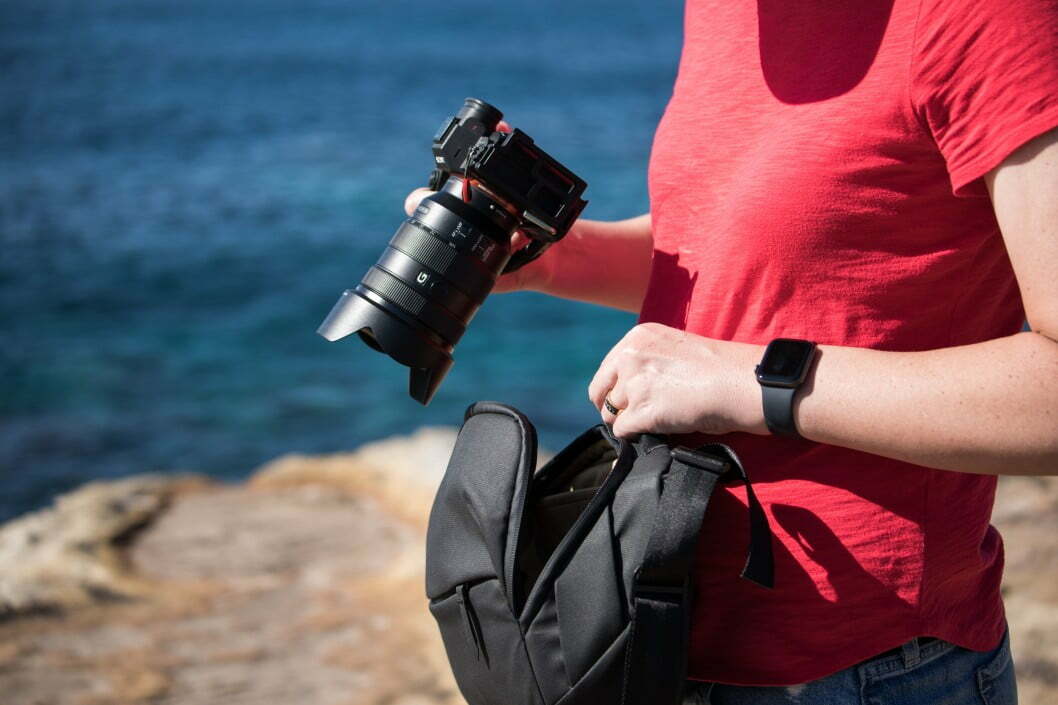Are you the family photographer and tired of being left out of family photos? Well, you need to start using your digital camera’s self-timer feature. This feature is usually found on everything from low-end models to the best digital cameras, so no matter what camera model you use, if you’re not familiar with what is a self-timer on a digital camera, read on to find out how to use this handy little function.
KEY TAKEAWAYS:
- The self-timer feature provides a delay between the time you press a shutter button and the actual firing of the shutter.
- It’s often used when a photographer wants to be included in the photo in some way.
- The self-timer can also be used to give you enough time to steady the camera before the photo is taken.
All You Need to Know About the Self-Timer Function
The self-timer option is a customizable setting that prevents the shutter from immediately releasing when you press the shutter release button. It gives you anywhere from a two to twelve-second delay to get yourself into position or make any last-minute adjustments before the camera snaps the picture. And while it may seem simple at first glance, it has numerous uses.
Insider Tip
Some digital cameras have a self-portrait timer that uses facial recognition technology to detect your face as soon as you’re in the frame.
When to Use Your Digital Camera’s Self Timer
Macro Photography
When it comes to taking super close shots of tiny subjects, your camera needs to be steady and stable. Using a 2-second delay self-timer will give you a chance to stabilize your camera after pressing the shutter button, so you don’t end up with motion blur from camera shakes. Of course, the self-timer isn’t the only key to macro photography. You also need to understand what is resolution on a digital camera.
Low Light Photography
The same is true in low-light situations. When you press the shutter button, your camera will shake for a few seconds, even if mounted on a tripod. If you don’t have a cable release, the custom self-timer feature will give the camera time to quit moving before starting the long exposure time often required for shooting in dark locations. To learn more about shooting in low light, read our explanation of what is the aperture on a digital camera.
Hands-Free Photography
If fine art or craft photography is your thing, your camera’s self-timer function is invaluable. This is especially true in situations where you need to capture images of your hands on the subject, such as when you’re modeling clay.
Shooting Groups
If you are the designated photographer for your family functions, a self-timer will make sure you aren’t excluded from the family’s group portrait. Once you have everyone in the right position, a 10-second delay self-timer will give you enough time to get into the shot.
F.A.Q.S
When should I use a remote shutter release?
Use a remote shutter release when you are shooting with long macro or telephoto lenses, using slow shutter speeds in low light situations, shooting in burst mode, or photographing timid or dangerous subjects.
How can I set continuous shooting mode on my digital camera?
From your camera’s menu, select Drive Mode. Then select how many images you want to capture per second. Finally, set the shutter speed.
What is the maximum number of seconds that a self-timer can provide?
You can select up to a 12-second delay before the camera shutter button is released.
STAT: In 2020, the overall sales of camera lenses dropped, and lenses wider than 35mm saw sales fall by 45%. (source)
REFERENCES:
- https://tw.canon/en/support/8203234600
- https://id.canon/en/support/8202799600
- https://www.sony-asia.com/microsite/cybershot_userguides/DSC-WX350/GB/cover/level3_14.htmlr
- https://en.wikipedia.org/wiki/Self_timer#:~:text=A%20self%20timer%20is%20a,people)%2C%20hence%20the%20name.
- https://www.youtube.com/watch?v=U9K3zy7YRLs&ab_channel=NoClueHowTo



































![Best Point and Shoot Camera in [year] ([month] Reviews) 27 Best Point and Shoot Camera in 2025 (December Reviews)](https://www.gadgetreview.dev/wp-content/uploads/Nikon-Coolpix-B500.jpg)
![Best Underwater Camera in [year] ([month] Reviews) 28 Best Underwater Camera in 2025 (December Reviews)](https://www.gadgetreview.dev/wp-content/uploads/best-underwater-camera-image.jpg)
![Best Digital Cameras in [year] ([month] Reviews) 29 Best Digital Cameras in 2025 (December Reviews)](https://www.gadgetreview.dev/wp-content/uploads/what-is-resolution-on-digital-camera-1.jpg)
![Best Digital Camera Docking Stations in [year] 30 Best Digital Camera Docking Stations in 2025](https://www.gadgetreview.dev/wp-content/uploads/best-digital-camera-docking-stations-image.jpg)
![Best Vlogging Camera in [year] ([month] Reviews) 31 Best Vlogging Camera in 2025 (December Reviews)](https://www.gadgetreview.dev/wp-content/uploads/best-vlogging-camera-image.jpg)
![Best Mirrorless Camera in [year] ([month] Reviews) 32 Best Mirrorless Camera in 2025 (December Reviews)](https://www.gadgetreview.dev/wp-content/uploads/best-mirrorless-camera-image.jpg)
![Best GoPro in [year] ([month] Reviews) 33 Best GoPro in 2025 (December Reviews)](https://www.gadgetreview.dev/wp-content/uploads/best-gopro-image.jpg)
![Best Digital Camera Tripods in [year] 34 Best Digital Camera Tripods in 2025](https://www.gadgetreview.dev/wp-content/uploads/best-digital-camera-tripods-image.jpg)
![Best Canon Digital Cameras in [year] 35 Best Canon Digital Cameras in 2025](https://www.gadgetreview.dev/wp-content/uploads/best-canon-digital-cameras-image.jpg)
![Best Polaroid Digital Cameras in [year] 36 Best Polaroid Digital Cameras in 2025](https://www.gadgetreview.dev/wp-content/uploads/best-polaroid-digital-cameras-image.jpg)
![Best Small Digital Camera Cases in [year] 37 Best Small Digital Camera Cases in 2025](https://www.gadgetreview.dev/wp-content/uploads/best-small-digital-camera-case-image.jpg)
![Best Digital Camera USB Cables in [year] 38 Best Digital Camera USB Cables in 2025](https://www.gadgetreview.dev/wp-content/uploads/best-digital-camera-usb-cable-image.jpg)
![Best Digital Camera Bags in [year] 39 Best Digital Camera Bags in 2025](https://www.gadgetreview.dev/wp-content/uploads/best-digital-camera-bag-image.jpg)
![Best Sony Digital Cameras in [year] 40 Best Sony Digital Cameras in 2025](https://www.gadgetreview.dev/wp-content/uploads/best-sony-digital-cameras-image.jpg)
![Best Panasonic Digital Cameras in [year] 41 Best Panasonic Digital Cameras in 2025](https://www.gadgetreview.dev/wp-content/uploads/best-panasonic-digital-cameras-image.jpg)
![Best Digital Camera Accessories in [year] 42 Best Digital Camera Accessories in 2025](https://www.gadgetreview.dev/wp-content/uploads/best-digital-camera-accessories-image.jpg)
![Best Kodak Digital Cameras in [year] 43 Best Kodak Digital Cameras in 2025](https://www.gadgetreview.dev/wp-content/uploads/best-kodak-digital-cameras-images.jpg)
![Best Video Cameras in [year] ([month] Reviews) 44 Best Video Cameras in 2025 (December Reviews)](https://www.gadgetreview.dev/wp-content/uploads/best-video-cameras-image.jpg)
![Best Compact Cameras in [year] 45 Best Compact Cameras in 2025](https://www.gadgetreview.dev/wp-content/uploads/best-compact-camera-image.jpg)
![Best Digital Cameras with Wifi in [year] 46 Best Digital Cameras with Wifi in 2025](https://www.gadgetreview.dev/wp-content/uploads/best-digital-camera-with-wifi-image.jpg)



















